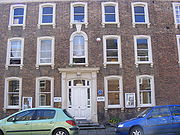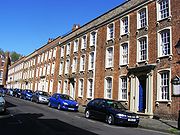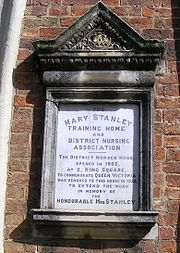
Castle Street, Bridgwater
Encyclopedia
Castle Street in Bridgwater
, Somerset
, England was built in the 1720s, on a site previously occupied by Bridgwater Castle
, by Benjamin Holloway or Fort and Shepherd, the Duke's London surveyors for James Brydges, 1st Duke of Chandos
. It was originally called Chandos Street. Many of the buildings have been designated as Grade I Listed buildings.
The buildings are made of red and yellow Flemish-bond brick, with moulded stone coping to the parapet, and follow very similar lines. They form an important group, unusual for their scale and ambition outside London's West End.
The buildings close to the quay on the River Parrett
were built for the merchants who managed trade through the port, with the first bridge having been constructed in 1200 AD. Quays were built in 1424; with another quay, the Langport slip, being built in 1488 upstream of the town bridge. The river was navigable, with care, to Bridgwater town bridge by 400–500 tonne vessels. By trans-shipping into barges at the town bridge the Parrett was navigable as far as Langport
and (via the River Yeo
) to Ilchester
. Many of the buildings still have undercroft
vaults, some of which were used by the Customs House which was once at the lower end of Castle Street and led to the naming of Bond Street which adjoins Castle Street.
Castle Street was used as a location in the 1963 film Tom Jones
.
In 2008, during sewer renovation work under Castle Street, a section of the curtain wall of the castle and a tunnel used to transport goods from the port were discovered.
 Number 1 on the corner with West Quay and very close to the River Parrett
Number 1 on the corner with West Quay and very close to the River Parrett
was built as the Harbour Master's house and is now used as offices.
Number 3 and 5 were originally separate houses but have now been made into one building and are used as offices. Number 7 and 9 follow the same pattern.
 Numbers 11 and 13 have been used as Bridgwater Arts Centre since 1946. Many of the original interior of the building has been lost but the plaster ceiling mouldings and the fireplace are original, as are the wooden side cupboards, the window panels and window seats. It was the venue for the first post-war meeting of the Congres Internationaux d'Architecture Moderne in 1947. Number 9 was purchased by Bridgwater Borough Council in 1966, which then passed into the ownership of Sedgemoor
Numbers 11 and 13 have been used as Bridgwater Arts Centre since 1946. Many of the original interior of the building has been lost but the plaster ceiling mouldings and the fireplace are original, as are the wooden side cupboards, the window panels and window seats. It was the venue for the first post-war meeting of the Congres Internationaux d'Architecture Moderne in 1947. Number 9 was purchased by Bridgwater Borough Council in 1966, which then passed into the ownership of Sedgemoor
District Council in 1974. Number eleven Castle Street was acquired as part of the arts centre in 1982.
 Number 2 which is on the corner with West Quay has the same Flemish-bond brick but has been painted.
Number 2 which is on the corner with West Quay has the same Flemish-bond brick but has been painted.
Number 4 has a vertical joint to Number 1 Bond Street on the left.
 Numbers 6, 8, 10 and 12 were originally a merchants houses and was used as nursing home from 1920 to 1990. The district nurses home originally opened in 1902 at Number 2 Kings Square to commemorate Queen Victoria but was moved to Castle Street in 1926.
Numbers 6, 8, 10 and 12 were originally a merchants houses and was used as nursing home from 1920 to 1990. The district nurses home originally opened in 1902 at Number 2 Kings Square to commemorate Queen Victoria but was moved to Castle Street in 1926.
Numbers 6 to 14 were also built as merchants houses and are now offices.
Bridgwater
Bridgwater is a market town and civil parish in Somerset, England. It is the administrative centre of the Sedgemoor district, and a major industrial centre. Bridgwater is located on the major communication routes through South West England...
, Somerset
Somerset
The ceremonial and non-metropolitan county of Somerset in South West England borders Bristol and Gloucestershire to the north, Wiltshire to the east, Dorset to the south-east, and Devon to the south-west. It is partly bounded to the north and west by the Bristol Channel and the estuary of the...
, England was built in the 1720s, on a site previously occupied by Bridgwater Castle
Bridgwater Castle
Bridgwater Castle was a castle in the town of Bridgwater, Somerset, England.-Early history:The castle was built in 1202 by William Brewer, like several other castle-builders of the period, an exceptionally wealthy man. He was granted the lordship of the Manor of Bridgwater by King John in 1201, and...
, by Benjamin Holloway or Fort and Shepherd, the Duke's London surveyors for James Brydges, 1st Duke of Chandos
James Brydges, 1st Duke of Chandos
James Brydges, 1st Duke of Chandos, MP, PC was the first of fourteen children by Sir James Brydges, 3rd Baronet of Wilton Castle, Sheriff of Herefordshire, 8th Baron Chandos; and Elizabeth Barnard...
. It was originally called Chandos Street. Many of the buildings have been designated as Grade I Listed buildings.
The buildings are made of red and yellow Flemish-bond brick, with moulded stone coping to the parapet, and follow very similar lines. They form an important group, unusual for their scale and ambition outside London's West End.
The buildings close to the quay on the River Parrett
River Parrett
The River Parrett flows through the counties of Dorset and Somerset in South West England, from its source in the Thorney Mills springs in the hills around Chedington in Dorset...
were built for the merchants who managed trade through the port, with the first bridge having been constructed in 1200 AD. Quays were built in 1424; with another quay, the Langport slip, being built in 1488 upstream of the town bridge. The river was navigable, with care, to Bridgwater town bridge by 400–500 tonne vessels. By trans-shipping into barges at the town bridge the Parrett was navigable as far as Langport
Langport
Langport is a small town and civil parish in Somerset, England, situated west of Somerton in the South Somerset district. The town has a population of 1,067. The parish includes the hamlets of Bowdens and Combe...
and (via the River Yeo
River Yeo (South Somerset)
The River Yeo, also known as the River Ivel or River Gascoigne, is a tributary of the River Parrett in north Dorset and south Somerset, England....
) to Ilchester
Ilchester
Ilchester is a village and civil parish, situated on the River Yeo or Ivel, five miles north of Yeovil, in the English county of Somerset. The parish, which includes the village of Sock Dennis and the old parish of Northover, has a population of 2,021...
. Many of the buildings still have undercroft
Undercroft
An undercroft is traditionally a cellar or storage room, often brick-lined and vaulted, and used for storage in buildings since medieval times. In modern usage, an undercroft is generally a ground area which is relatively open to the sides, but covered by the building above.- History :While some...
vaults, some of which were used by the Customs House which was once at the lower end of Castle Street and led to the naming of Bond Street which adjoins Castle Street.
Castle Street was used as a location in the 1963 film Tom Jones
Tom Jones (film)
Tom Jones is a 1963 British adventure comedy film, an adaptation of Henry Fielding's classic novel The History of Tom Jones, a Foundling , starring Albert Finney as the titular hero. It was one of the most critically acclaimed and popular comedies of its time, winning four Academy Awards...
.
In 2008, during sewer renovation work under Castle Street, a section of the curtain wall of the castle and a tunnel used to transport goods from the port were discovered.
South side

River Parrett
The River Parrett flows through the counties of Dorset and Somerset in South West England, from its source in the Thorney Mills springs in the hills around Chedington in Dorset...
was built as the Harbour Master's house and is now used as offices.
Number 3 and 5 were originally separate houses but have now been made into one building and are used as offices. Number 7 and 9 follow the same pattern.

Sedgemoor
Sedgemoor is a low lying area of land in Somerset, England. It lies close to sea level south of the Polden Hills, historically largely marsh . The eastern part is known as King's Sedgemoor, and the western part West Sedgemoor. Sedgemoor is part of the area now known as the Somerset Levels...
District Council in 1974. Number eleven Castle Street was acquired as part of the arts centre in 1982.
North side

Number 4 has a vertical joint to Number 1 Bond Street on the left.

Numbers 6 to 14 were also built as merchants houses and are now offices.

